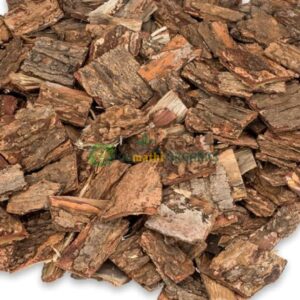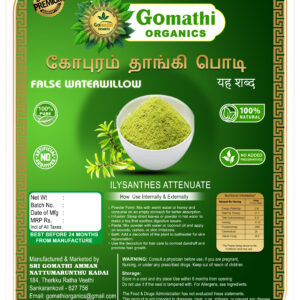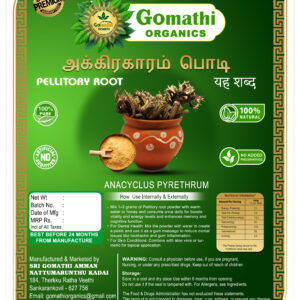Description of Black Turmeric
🌼 Black turmeric features dark green leaves adorned with a red stripe in the center and bluish-black rhizomes that taste bitter. Its aroma is strong and It has a camphor-like smell. Karu manjal plant thrives in moist, well-drained, nutrient-rich organic soil, like sandy or clay loam. It should be kept consistently moist during the growing season and supplemented with liquid fertilizer to ensure healthy growth.
🌼 Black turmeric is a scarce herb that stands out from the more familiar orange turmeric. Its flesh boasts a unique bluish-purple hue, which can sometimes appear completely blue or display light and dark concentric circles, with color variations that may be lighter at the center or closer to the skin.
Morphological characteristics of Black Turmeric (Curcuma caesia)
🌿 Stem: Black turmeric plants have short stems that are flat and green
🍂 Leaves: Black turmeric leaves are large, oblong, and lanceolate with an acuminate tip and base. The upper surface of the leaf is rough, while the lower surface is smooth. The leaves are usually dark green with a purplish red mid vein.
🥕 Rhizomes: Black turmeric rhizomes are ovoid, knobby, and have tapered to blunt ends. They are often branched and brownish yellow in color, but can also be dark brown, tan, or light beige. The surface of the rhizome is covered in scars, root hairs, rings, and nodes. The skin of the rhizome is tough, rough, and corky.
🌱 Roots: Black turmeric plants have many fibrous roots.
☘ Aerial shoots: Black turmeric plants have aerial shoots, also known as pseudostems.
Habitat of Black Turmeric (Curcuma caesia)
🌼 Black turmeric (Curcuma caesia) grows in humid, rich, and clayey soils in the Himalayan region, including India and Southeast Asia. It’s found in the following regions of India: Tamil Nadu, West Bengal, Madhya Pradesh, Orissa, Chhattisgarh, Uttar Pradesh, North-east India, Papi Hills of East Godavari, West Godavari, and Andhra Pradesh
🌼 Black turmeric plant originates from India and South-East Asia. It grows in rich humid and clayey soils among them curcuma longa. The plant grows best in temperatures between 20°C to 30°C (68°F to 86°F).
Black Turmeric Organic Information
🌼 Experience the delightful simplicity of our specialty – a completely authentic, vegetarian product that contains no artificial colors, harmful chemicals, pesticides, or additives. Carefully packaged in a pristine environment, we guarantee unmatched freshness and purity. Proudly crafted in India, savor the true essence of authenticity.
Black Turmeric (Curcuma caesia) Names in different languages
⭐ Family Name: Zingiberaceae
⭐ Botanical (Latin) name: Curcuma caesia
⭐ Sanskrit: Krishna Haridra (कृष्णा हरिद्रा)
⭐ English: Black Turmeric
⭐ Tamil: Karu Manjal (கரு மஞ்சள்)
⭐ Hindi: Kali Haldi (काली हल्दी), Narkachur Narkachoor, Krishna kedar (कृष्ण केदार)
⭐ Telugu: Nalla Pasupu (నల్ల పసుపు)
⭐ Kannada: Kari Arishina (ಕರಿ ಅರಿಶಿನ), naru kachora
⭐ Malayalam: Karutha Manjal (കരുത്ത മഞ്ഞൾ)
⭐ Punjabi: Kali Haldi (ਕਾਲੀ ਹਲਦੀ)
⭐ Bengali: Kala Halud (কলা হলুদ)
⭐ Gujarati: Kali Haldi (કાળી હલદી)
⭐ Malayalam: Karutha Manjal (കരുത്ത മഞ്ഞൾ)
⭐ Marathi: Kali Halad (काळी हळद)
⭐ Odia: Kala Haladi (କଳା ହଳଦୀ)
⭐ Assamese: Kala Haladhi (কালা হালধি)
⭐ Urdu: Kali Haldi (کالی ہلدی)
⭐ Konkani: Kalo Halad
⭐ Tulu: Kari Manjal
⭐ Meitei (Manipuri): Yaimu Takhel, Yaingang Amuba (যাঈঙাঙ অমূবা)
⭐ Dogri: Kali Haldi
⭐ Kashmiri: Kali Haldi
⭐ Maithili: Kala Haldi
⭐ Chhattisgarhi: Kali Haldi
⭐ Rajasthani: Kali Haldi
⭐ Sindhi: Kali Haldi
⭐ Mizo: Aihang, Ailaihang
⭐ Nepali: Kala Besar (काला बेसार), Kaalo haledo (कालो हलेदो)
⭐ Arabi: Kurkum Aswad (كركم أسود)
Nutrition Facts (Approximate per 100 g of Dried Curcuma caesia)
❦ Calories: 312 kcal
❦ Protein: 7.8 g
❦ Fat: 3.2 g
❦ Carbohydrates: 67.6 g
❦ Fiber: 22 g
❦ Sugar: 2.6 g
❦ Iron: 5.4 mg
❦ Calcium: 152 mg
❦ Vitamin C: 22 mg
❦ Potassium: 952 mg
❦ Magnesium : 193 mg
❦ Curcuminoids : Rich in Antioxidants, but lower voncentrations than yelleow turmeric
Nutritional Information
❦ Vitamin C, Carbohydrates, Curcuminoids, antioxidants, Large amounts of Fiber, Protein, calcium and magnesium.
Recommended Dosage
❦ Capsules: 500 mg, 1-3 times daily.
❦ Tincture: 10-20 drops, 2-3 times a day.
❦ Tea/Powder: 1-2 grams in hot water, 1-2 times per day.
❦ Root powder – 3-5gm
❦ Root extract – 3gm
How to consume Internally
❄️ Morning – Mix 1/4 teaspoons of Mara Manjal Powder with 100ml of warm water daily after Food. Repeat the same for the Evening Dosage after dinner. as directed by your health Practitioner.
❄️ Take 5 grams of yellow vine powder and mix it with 100 ml of water. Boil the mixture. Consume the mixture every morning and evening to treat diabetes.
❄️ Mix 1/4 tsp of Maramanjal powder with warm water, honey, or herbal tea.
❄️ Use in cooking or herbal blends for added benefits.
How to Apply Externaly
❄️ Apply a paste of black turmeric powder and water to cuts or wounds to promote healing and reduce infection.
❄️ Mix black turmeric powder with coconut oil, warm it slightly, and massage onto the affected area to relieve inflammation and pain.
❄️ Make a face mask with black turmeric powder and aloe vera gel to reduce acne and brighten the skin
How to Store
☀️ Keep in an airtight container away from moisture and direct sunlight.
☀️ Ensure the lid is tightly closed after every use.
Caution to Be Taken
⚡ Consult a physician if pregnant, breastfeeding, or on medication.
⚡ There may be interactions with medications, particularly those affecting blood sugar and blood pressure levels.
⚡ Avoid excessive consumption to prevent toxicity.
⚡ Not suitable for infants or children without medical advice.
⚡ Not recommended for long-term use without medical guidance.
⚡ Always consult a healthcare provider for personalized dosage.
Important Tips
☀️ Initiate 🌱 with a Low Dose: Start with a minimal amount to observe how your body responds.
☀️ Use Moderately: 🌿 Avoid excessive, long-term use without guidance
Prioritize Quality: 🍁 Purchase from trusted vendors to ensure product purity
☀️ Conduct a Patch Test: 🍂 Always conduct a patch test before applying to the skin
☀️ Storage Considerations: 🍃 Avoid metal containers to maintain the product’s effectiveness.
Harvesting & Manufacturing Method
☀️ All of our herbs are harvested organically, dried, and ground without chemical interaction, guaranteeing 🌳 that our herbal powders and related products are entirely natural.
☀️ Sourced from sustainably 🌿 cultivated Coscinium plants found in tropical mountains and forests.
☀️ These herbs are carefully picked by🌱 hand and dried in the sun to maintain and preserve, their nutritional benefits.
☀️ They are Processed without any additives or chemicals, 🌾 ensuring, and guaranteeing their natural purity.
Medicinal Uses and Health Benefits
- Anti-inflammatory
- Pain Relief
- Arthritis Remedy
- Digestive Aid
- Skin Health
- Anti-cancer Properties
- Detoxifying Agent
- Liver Health
- Blood Purification
- Wound Healing
Cosmetic and Skin Care Applications
- Natural Skin Brightener
- Anti-acne Treatment
- Anti-aging Properties
- Herbal Face Masks
- Scalp Health
- Herbal Skin Soother
- Healing Skin Irritations
- Skin Rejuvenation
Respiratory and Immune System Health
- Cold and Cough Remedy
- Respiratory Health
- Asthma Relief
- Immunity Booster
- Expectorant Properties
- Sore Throat Treatment
- Bronchitis Relief
Botanical and Ecological Tags
- Curcuma Caesia
- Curcuma Family
- Zingiberaceae Family
- Tropical Herb
- Perennial Herb
- Medicinal Root Plant
- Native to South Asia
- Wild Medicinal Herb
- Native Habitat
- Drought-resistant Plant
Pharmacological and Chemical Aspects
- Curcuminoids
- Zedoarene
- Bioactive Compounds
- Antioxidant Properties
- Anti-microbial Effects
- Phytochemical Studies
- Volatile Oils
- Tannins and Flavonoids
Traditional and Cultural References
- Kali Haldi
- Krishna Haridra
- Black Zedoary
- Indian Snake Root
- Black Ginger
- Nepali Haldi
- Traditional Ayurvedic Herb
- Siddha Medicine
- Folk Medicine
- Sacred Herb in Rituals
Ayurvedic and Siddha Significance
- Vata Dosha Balancer
- Pitta Dosha Remedy
- Kapha Dosha
- Ayurvedic Elixir
- Tridosha Balancing
- Anti-cancer Herb in Ayurveda
- Boosting Immunity
- Anti-inflammatory for Joints
Culinary and Practical Uses
- Herbal Spice
- Cooking Herb
- Herbal Tea
- Natural Food Coloring
- Traditional Recipes
Environmental and Conservation Tags
- Sustainable Plant Use
- Wildcrafting
- Medicinal Plant Conservation
- Native Habitat Protection
- Sustainable Harvesting
- General Identification Keywords
- Black Turmeric Benefits
- Kali Haldi Uses
- Curcuma Caesia Medicinal Properties
- Krishna Haridra Ayurveda
- Rare Black Turmeric Herb
- Medicinal Haldi Varieties
- Ayurvedic Herbs Black Turmeric
- Health and Wellness Keywords
- Black Turmeric for Immunity
- Herbal Remedies for Inflammation
- Black Turmeric Health Benefits
- Natural Pain Relief with Black Turmeric
- Holistic Healing with Kali Haldi
- Antioxidant-Rich Herbs
- Medicinal Uses Keywords
- Black Turmeric for Skin Health
- Kali Haldi for Joint Pain
- Curcuma Caesia for Digestion
- Natural Detox with Black Turmeric
- Anti-Inflammatory Herbal Solutions
- Respiratory Health with Black Turmeric
- Ayurvedic and Traditional Keywords
- Black Turmeric in Ayurveda
- Vedic Remedies with Kali Haldi
- Ancient Herbal Solutions
- Sacred Indian Herbs
- Rare Ayurvedic Medicinal Plants
- Siddha Medicine and Black Turmeric
- Product and Commercial Keywords
- Organic Black Turmeric Powder
- Buy Black Turmeric Online
- Herbal Supplements with Kali Haldi
- Black Turmeric Extract Benefits
- Natural Health Products Black Turmeric
- Farm Fresh Black Turmeric
- Farming and Cultivation Keywords
- Organic Cultivation of Black Turmeric
- Medicinal Plant Farming in India
- Sustainable Herbal Farming
- Black Turmeric Wild Harvesting
- Curcuma Caesia Farming
- Scientific and Research Keywords
- Curcuma Caesia Health Research
- Black Turmeric Phytochemistry
- Medicinal Properties of Black Turmeric
- Ayurvedic Research on Kali Haldi
- Rare Medicinal Plants Studies
- Culinary and Dietary Keywords
- Black Turmeric Tea Benefits
- Herbal Drinks with Black Turmeric
- Detox Drinks with Kali Haldi
- Natural Ingredients for Health
- Black Turmeric Recipes
- Market and Trending Keywords
- High Demand Medicinal Herbs
- Trending Herbs for Health
- Rare Indian Herbal Products
- Black Turmeric Market Trends
- Top Ayurvedic Herbs
- Regional and Cultural Keywords
- Kali Haldi Traditional Uses
- Medicinal Herbs of India
- Krishna Haridra Regional Benefits
- Black Turmeric Cultural Significance
- Indian Sacred Herbs
Black turmeric – Curcuma caesia
black turmeric, curcuma caesia, kali haldi, black zedoary, black hardy, dried black turmeric, ginger, curcuma aeruginosa, black ginger, turmeric powder, exotic turmeric, black curcuma, indian snakeroot, rauvolfia serpentina, premium turmeric, anticarcinogenic, medicinal plants, kaempferia rotunda, medicinal herbs, rare herbs, indian spices, turmeric, herbs for tea, rhizome, ayurveda, made in usa, edible garden, ginger rhizome, zingiber purpureum, cassumunar ginger, zingiber cassumunar, purple ginger, herb garden, zingiber montanum, ginger roots, ginger plants, green turmeric, ginger plant, kencur, aromatic ginger, kaempferia galanga, rhizomes, jamu, capsules, medicinal benefits, hand-harvested, health-enhancing, unique ingredient, ayurvedic super food, chemical free, curcumin rich powder, antioxident powder, anti inflammatory, black turmeric powdr, supplement, women health, tongkat ali, bladderwrack, thunder vine, devil pepper, galangale, ginger powder, spicy flavor, golden spice, , immune booster, culinary ingredient, curcumin extract, medicinal herb, Kali Haldi – काली हल्दी – Long Zedoary – Narkachoor – Nar Kachur- Nar Kachoor – Black Turmeric – Curcuma Zerumbet









Reviews
There are no reviews yet.